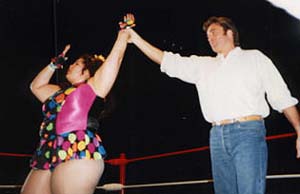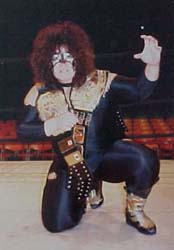REAL NAME: Rhonda Sing
BORN: February 21, 1961 in Calgary, Alberta
5’8″, 260 pounds
DIED: July 27, 2001
AKA: Monster Ripper, Rhonda Singh, Bertha Faye

Rhonda Singh blows kisses to the crowd. — Photos by Jim Divito
One of the most fearsome women to ever enter a wrestling ring, Rhonda Sing has lead a long and fascinating career few North American wrestling fans are aware of.
While growing up in Calgary, Sing knew she wanted to be a wrestler from an early age and attended numerous Stampede Wrestling cards as a child.
“Stampede Wrestling was a big influence because you had it on TV Saturday mornings,” she told SLAM! Wrestling. “My mom used to go and took us if we had been good through the week. She always had four ringside tickets for about 20 years. When I was five, I wanted to be a wrestler. I was in kindergarten beating up the other kids. Everyone who knows me in my neighbourhood remember me telling them I was going to be a wrestler. It’s like a lot of the wrestlers in the business now — they knew it when they were kids.”
As a teenager, Sing approached members of the Hart family asking to be trained. Despite being rejected, she still dreamed of becoming a professional wrestler. A trip to Hawaii in 1978 changed her life forever as she saw Japanese women’s wrestling on television.
“I was actually in Hawaii on vacation and zapping through the channels, I stumbled on Japanese women’s wrestling. They were hitting each other with chairs and everything! It was an all-girl company, and I thought it was the coolest thing. It sparked my interest. This was definitely what I wanted to do,” said Sing.

Monster Ripper
A friend gave 17-year-old Sing a wrestling magazine which contained contact information for Mildred Burke’s training facility in Encino, California. She wrote the women’s wrestling legend and sent along a biography and photo. After receiving a reply from Burke, she made a decision which changed her life.
“I cleaned out my bank account and told my parents this is what I wanted to do,” she recalled. “I said to my parents, ‘give me three months, let me see if I can do this.'”
After a few weeks of training with Burke, Sing was scouted by All-Japan who wanted to bring her in despite her inexperience.
“Some of the Japanese girls came to L.A. to train and scout some talent. Burke was the only U.S. trainer having women go over to Japan at the time. They were saying ‘Hey! A fat girl! We like her,'” she laughed. “That was in November, and by January I was main eventing in Japan. I could tie my boots and do a backdrop. I was pretty limited.”
Her first match in Japan was with partner Mami Komeni against Beauty Pair (Jackie Sato and Maki Ueda) on January 4, 1979. She recalled it fondly, but knew how significant the win was.
“It was my first match, and I won. The Japanese girls resented it because they never had to lose. If they lost, they lost to each other. They never lost to a foreigner.”
A combination of youth and inexperience made life in Japan somewhat difficult for Sing during her first few months there.
“They literally kicked the s**t out of me,” she said. “I was the first foreigner they had to lose to, and they didn’t take it kindly. You were working seven, eight times a week. You had to roll out of bed and bit-by-bit get up because you were just dead.”
Many of the established Japanese wrestlers were unwilling to share their experience with the young Canadian wrestler. It was not until she ran into a touring Dynamite Kid that she was able to gain a greater grasp of how to deal with her fellow wrestlers.
“It was just a matter of defending yourself and saying ‘I’m not going to take this anymore!’ Once you got respect, it became very easy. They always respected you and feared you.”
Sing’s first run in All-Japan peaked when she won their Women’s World Title from Jackie Sato on July 31, 1979 — a little over six months after her professional debut. Despite losing the title to Sato six weeks later, she regained it on March 15, 1980 via countout after outside interference from the Black Pair (Mami Kumao and Yumi Ikeshita). The title was vacated in August 1980 after another epic battle with Sato.
A brief return to Calgary in the early ’80s allowed Sing the chance to finally perform in front of her hometown crowd.
“I didn’t want to wrestle there until I knew I was going to be good enough,” she said. “This is your hometown crowd and people you grew up with. The first time I came through, I was with a Mexican girl (Rita Moreno) that was in Japan as well. We were only going to do two weeks. Stu (Hart) liked us so much, he kept us for four. He wanted us longer, but we had to go back to Mexico.”
After another stint in Japan, Sing returned to Stampede on a regular basis in late 1987 and was named their Women’s Champion as she had defeated Wendi Richter before coming back to the territory. She held the title until September 22, 1988, losing to Chigusa Nagayo.
The camaraderie of Stampede appealed to Sing at the time, and she does not see the same level of it in today’s locker rooms.
“This was one of the best territories anyone could work in,” she said. “The people you met there are still your friends. Everyone had a good time. You didn’t have the problems you have in the dressing room now. There was never anything that ever escalated into a major problem.”
Over the next few years, Sing would once again travel throughout the world and wrestle for a number of promotions, holding several titles. She feels lucky to have been able to see many parts of the world.
“In this business you’re really fortunate because it allows you to see a lot of the world you would never see,” she said.
In 1995, Sing was contacted by the WWF to add depth to their fledgling women’s division. However, she was repackaged as Harvey Whippleman’s trailer park-dwelling girlfriend Bertha Faye. Sadly, this is how many North American fans remember her.
“It was the best and worst of times. Because I started in Japan, I had a reverse philosophy than those who start in the States, and their dream is to wrestle in Japan. Mine was to wrestle in Madison Square Garden,” said Sing.
Strangely enough, Sing did have an opportunity several years before to fulfill her dream, but chose to wait.
Monster Ripper: Japanese success story.
“I had that opportunity years ago when they had Wendi Richter,” she said. “Moolah called me up and said she wanted me to do a couple of pay-per-views with Wendi. The thing was, Moolah wanted half my money. Why would you take my money when you’re doing nothing? I didn’t even know her! You wanted to go, but you knew it was going to be a guaranteed loss.”
The original plan was to be part of an angle with Bull Nakano, who she had many epic battles with in Japan, which was meant to develop fan interest in the women’s division.
“We had big heat in Japan, so this is what they wanted to do,” she recalled. “Madusa was going away, and she was getting new boobs and a new nose. For three months, it was going to be Nakano and I. She was going to drop the belt to me, Madusa was going to come back after a while, we’d add a few more girls and make it a legitimate women’s division. Eventually, Madusa and I would battle for the belt and it was undecided from there. I had a two-year contract, so we were going to space it out over that time”
But that isn’t how it happened. Nakano was found in possession of cocaine which prompted a change of plans. She made her WWF debut on an episode of Monday Night Raw participating in a sneak attack Madusa making it appear as if they had broken her nose. Sing was not pleased with the development.
“The whole storyline went down the toilet,” she said. “The only way we could save it was if we were to hurt Madusa because she was still scheduled for surgery. We had to get rid of Nakano and get me in at the same time.”
Sing was also hesitant to work with Madusa after hearing numerous rumours about how she behaved behind-the-scenes and focused on Madison Square Garden.
“I sort of saw through her before I even worked with her,” she said. “I hit Madison Square Garden in September 1995 and I didn’t care after that. I went in a champion and left as champion. It was one of my better matches with her. None of the others were anything you’d write home about compared to what you could do.”
During her stint with the WWF, she also developed a great friendship with the late Owen Hart.
“I was working in Calgary when he and (Chris) Benoit started,” she recalled. “Owen really saved me when I was with the WWF. I rode with the Canadian guys, so I travelled with him a lot when I was on the shows. There’s no one you’ll ever be able to replace Owen with.”
Despite the ridiculous antics of Whippleman and Faye, which included wearing garish outfits and hideous makeup, she did notice how his character was essentially an extension of his own personality.
“He actually did live in a trailer park. He was that guy, that’s who he is. He’s never bought a roll of toilet paper in his life. He’d always take it from a hotel or a truck stop.”
Sing also found it incredibly difficult to adopt a new persona after spending almost all of her career as Monster Ripper.
“They put me in that character, you’re not doing something you want to do. I was Monster Ripper for 15 years. It was hard to walk away from that personality.”
With her character creatively restricted, Sing was also limited to what moves she could perform in the ring. She was not allowed to used an overhead press or a powerbomb as other WWF stars were utilizing them at the time.
“I couldn’t do these moves because certain guys were doing it,” she said. “You went in every night with one arm tied behind your back because someone else laid claim to it. I was doing these moves on a daily basis for 15 years, and now I couldn’t do it. No one wanted you to look better than they did. I did power moves, that’s who I was. It sort of stripped my identity. You’re going to the ring skipping and blowing kisses, looking goofy. You just went to the bank and cashed your cheque. You felt like you were pimping yourself out. You were like a prostitute for Vince. The guys were doing it too, so you know what people will do for money.”
Fan interest in women’s wrestling sunk once again as the year closed, even with the addition of Japanese star Aja Kong. Sing believes there are several reasons why the women’s division ultimately failed.
“There was no real storyline,” she said. “There was nothing really going on. We were just there. In the background, you’d have Madusa calling Vince all the time asking why we weren’t on TV. When you only have two girls, you can only do so much. She had very limited skills, she did basically the same thing all the time. I think she sort of sabotaged everything.”
After a year as Bertha Faye, she had the WWF release her from her contract. She briefly returned to Japan, but found it difficult to adjust to a new system without guaranteed payouts.
In late 1999, she made a brief return with World Championship Wrestling and appeared on several telecasts to generate some interest in a women’s division. While her stay was brief, Sing appeared to enjoy her time with the promotion.
Preparing to crush an opponent. — Photo by Jim Divito
“I like them,” she said. “They’re an upfront organization. When I called them, they knew what they wanted me to do. There’s no secret agenda.”
Women’s wrestling had changed greatly in the time since Sing was last with a major North American promotion, and she was well aware of the limitations her opponents had.
“It’s a different era. None of them can last as long. You used to be able to wrestle 55 minutes. These girls can’t wrestle more than 10. Now the they only know five holds, and that’s all they have,” she remarked.
However, Sing does believe it is possible for a woman to become an elite competitor if they train with organizations which allow them to develop properly.
“They all have the potential to do more. If you send any of the girls working now to Japan, they’ll come back the best wrestler ever turned out. They have basic body skills, they just need the ring sense.”
Despite the fact she has not wrestled in several months, Sing would not hesitate to return to another major promotion as long as she was treated properly.
“Oh yeah, you’d work for anybody,” she said. “I’ve got no loyalty. It’s whoever is going to pay me. It’s always been my philosophy. As long as you pay me and treat me fairly, I’ll work for you.”
RELATED LINKS
https://slamwrestling.net/index.php/2001/08/09/sings-legacy-tainted-by-bertha-faye/
Memories
When I heard the death of my favorite woman wrestler and friend I cried my eyes out and started remembering her days in the WWF and WCW where I remembered her. I also knew about her times with Stampede but never saw her wrestle cause I am only 17 and never seen her there. My memory of her is a day while she was in WCW. It was against Miss Elisabeth. This was Liz’s first actual real match and Rhonda tried not to be rough on the fragile Liz and I don’t really remember who won this match but I do remember I had a few laughs out of it. Sadly I would never her see her in WCW after that.
ChrisBrgstrm@aol.com
I remember when I was growing up in Edmonton and my parents would take me to Stampede wrestling at the Agricom and every time Rhonda saw me she would come pick me up and must keep giving me kisses on the cheek and take me in the back with her. I was about 14 years old and I was Stu Hart’s birthday show in Calgary and Rhonda Singh saw me and she remembered me and gave me great big kiss on the cheek and she made me promise her that I would get into wrestling when I was old enough. Well it was Rhonda’s Birthday and we were both booked on a Can/Am Wrestling card in Edmonton and I was the ref for the evening and when she saw me in the ring ready to ref her match she was almost in tears and from that time on I had many more chances to work with Rhonda and she will always be my favorite lady in the business to work with and she was a true champion and friend in my life. God Bless you Rhonda.
Sqiggy Magoo, Alberta Referee
OK, so I was one of the people who laughed at The Bertha Faye gimmick and thought nothing of her abilities, but after her WWF debut, I watched previous matches and was impressed with Singh. I had the pleasure of seeing her wrestle Alundra Blayze in Madison Square Garden for the WWF Women’s Title. The saying is true, you don’t know what you got until you lose it. As a huge fan of women’s wrestling, the loss of Rhonda Singh is indeed a great one. Rest In Peace, Rhonda. We, the fans, and the world of professional wrestling will never forget you.
IvoryHHH@aol.com
Rhonda will always be alive in my memories. In my view, she really solidified what women’s wrestling is today. After seeing her World Wrestling Federation debut as Bertha Faye, I was really impressed with Rhonda’s talent in the ring, as was proven when she won the WWF World Women’s Championship from Alundra Blayze at SummerSlam ’95. Along with Ted DiBiase, Fred Blassie, and Jerry Lawler, Rhonda Singh will always and forever be a role model in my life.
rekonken@webtv.net
I never met or knew Rhonda, but if she was a friend of the Harts, she would of been a friend of mine. I AM SOOOOOOoooooo sorry to hear of Rhonda’s passing. SHE HAD TO BE ” GREAT” …I only wish I could of met her.
PENNY BANNER (RETIRED WRESTLER who LOVED THE HARTS AND THE CANADA TERRITORY). 1954-1960
I am a long time fan of women’s wrestling, and Rhonda was one of my all time favorites. Unlike the women “wrestlers” nowadays, Rhonda did things the right way by training with the legendary Mildred Burke, and then travelling the world to Japan, Mexico, Canada, Europe, and the United States in order to become arguably the top woman wrestler around. I draw cartoons of women wrestlers as a hobby, and I have sent out color copies to many women wrestlers. I sent them to Rhonda last year, and I hope she liked them. I also hope she was not offended by the fact that I drew her in her Bertha Faye persona, but to be honest with you, I thought she did a fine job in that role. She will fondly be remembered by us fans.
Ken Raftery
